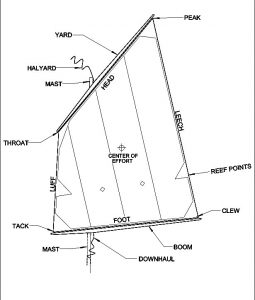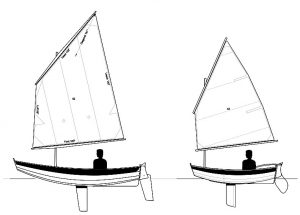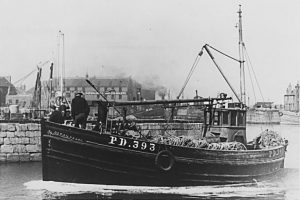April-May 2023: Seen from Stone Point
On watch at NCI Stone Point we see a wide range of vessel types. Here is a small sample of some of them:
The Clipper yachts are choosing and training crews for the next Clipper Round-the-World race which will start in late summer 2023. The Clipper photos, and the photos of what we presume were anti-oil protest boats, were taken by other watchkeepers using the station camera. Vessels I did see included the pedalo crossing to the Isle of Wight, Polly Agatha (based locally but not often seen fully canvassed), and the Dutch submarine, Southampton bound.
The fishing vessel “Ocean Pearl” (PD393) is perhaps the most interesting. She was built in Fraserburgh in 1933 as a fishing seiner. Between 1997 to 2007 she was restored as a sailing vessel with a standing lug rig.
Seeing her has prompted me to find out more about lug rigs. Like a gaff rig, they have the advantage of keeping the centre of effort lower for a given sail area compared to a sloop rig. They are classed into three types, dipping, balanced, and standing.

Parts of a lug sail (from Lug Nuts)
One can imagine the dipping lug sail as evolving from a square sail sheeted more or less fore-aft. The problem is that you can’t get the aerofoil cross section unless you define one side to be the luff and the other the leach and shape the sail cloth. Having done that you can’t just rotate the sail around the mast when you tack, you have to lower the sail, dip the yard to bring it to the other side of the mast, and reset the sail. Definitely not a good rig for short tacking!
The balanced lug is like the dipping lug but you don’t move the yard to the other side of the mast when you tack. You get away with that by using a much flatter sail so that on the “bad” tack the effect of the mast on the sail shape is not too disastrous.

(left) Balanced lug sail; (right) standing lug sail (from Lug Nuts)
The balanced lug sail is rigged with a boom to which the tack is secured. Provided the halyard and downhaul are set up hard to give a taught luff, a kicking strap (or boom vang) is not needed. Any tendency for the sail to twist would require the peak to come closer to the clew but that is countered by the tension of the luff, an interesting design feature! I presume also that there is no need for sail battens since there is little or no roach.
The standing lug sail is similar to the balanced lug but the tack is moved close to the mast. This either allows for the mast to be steeped further forward in the boat, or provides space to rig foresails. The sail can be set without a boom and the sail may have more of a roach, in which case sail battens might be required.
As sighted off stone point, in her new reincarnation “Ocean Pearl” is a ketch with two standing lug sails and space forward to carry a staysail and what looks like an assymetric spinnaker with top-down furling.

![[01] 15:52 13th April One Of The Clipper Yachts (station Camera)](https://seatern.uk/wp-content/uploads/2023/06/DSCN0054ps-300x200.jpeg)
![[02] 15:52 13th April One Of The Clipper Yachts (station Camera)](https://seatern.uk/wp-content/uploads/2023/06/DSCN0052ps-300x200.jpeg)
![[03] 17:18 14th April Protest Boats? (station Camera)](https://seatern.uk/wp-content/uploads/2023/06/DSCN0055ps-300x200.jpeg)
![[04] 17:18 14th April Protest Boats? (station Camera)](https://seatern.uk/wp-content/uploads/2023/06/DSCN0060ps-300x200.jpeg)
![[05] 14:51 18th May Pedalo With Dragon Or Swan Head And (fortunately) Safety Rib.](https://seatern.uk/wp-content/uploads/2023/06/DSC05947ps-300x200.jpeg)
![[06] 13:25 20th May Two Classic Vessels](https://seatern.uk/wp-content/uploads/2023/06/DSC05950ps-300x200.jpeg)
![[07] 13:25 20th May Polly Agatha Fully Rigged](https://seatern.uk/wp-content/uploads/2023/06/DSC05951ps-300x200.jpeg)
![[08] 13:57 23rd May Ex Fishing Vessel Ocean Pearl PD393](https://seatern.uk/wp-content/uploads/2023/06/DSC05954ps-300x200.jpeg)
![[09] 13:57 23rd May Ex Fishing Vessel Ocean Pearl PD393](https://seatern.uk/wp-content/uploads/2023/06/DSC05956ps-300x200.jpeg)
![[10] 14:04 23rd May Ex Fishing Vessel Ocean Pearl PD393](https://seatern.uk/wp-content/uploads/2023/06/DSC05957ps-300x200.jpeg)
![[11] 14:00 26th May Dutch Submarine Passing East Lepe Buoy](https://seatern.uk/wp-content/uploads/2023/06/DSCN0068ps-300x200.jpeg)
![[12] 14:08 26th May Dutch Submarine Southampton Inbound](https://seatern.uk/wp-content/uploads/2023/06/DSC05967ps-300x200.jpeg)
